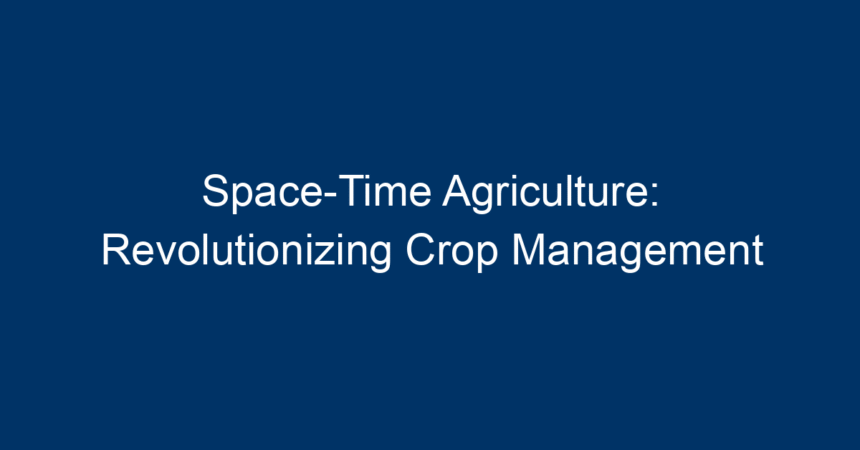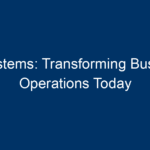In an era where food production must keep pace with a rapidly growing global population, innovative agricultural practices are no longer optional; they’re essential. One of the most promising developments is space-time agriculture, a transformative approach that combines advanced spatial and temporal data analysis to optimize crop management. This article dives deep into the concept of space-time agriculture, its benefits, and its potential to revolutionize how we grow our food.
Understanding Space-Time Agriculture
What is Space-Time Agriculture?
Space-time agriculture is an integrative farming approach that utilizes geographic information systems (GIS), remote sensing, and advanced data analytics to enhance agricultural productivity. By considering both spatial and temporal variables, farmers can make informed decisions regarding sowing times, water usage, pest control, and crop rotation strategies.
The Science Behind It
At the heart of space-time agriculture lies big data. With data collected from satellites, drones, and ground sensors, farmers can analyze patterns over time and space. This allows for precise applications of resources, targeted interventions, and optimized yield predictions. The integration of cutting-edge technology ensures that agricultural practices align closely with environmental conditions.
Benefits of Space-Time Agriculture
1. Enhanced Crop Yield
One of the most significant advantages of space-time agriculture is its potential to dramatically increase crop yields. By analyzing data related to soil health, weather patterns, and crop growth stages, farmers can make timely interventions that lead to healthier crops. For example, knowing the exact moisture levels in a field allows for precise irrigation, which can prevent either overwatering or underwatering.
2. Sustainable Resource Management
Traditional agriculture often leads to resource wastage, whether it’s water, fertilizers, or pesticides. Space-time agriculture enables better resource management by allowing farmers to apply inputs only where and when they are needed. This not only saves costs but also minimizes environmental impact—a win-win for farmers and the planet.
3. Improved Pest and Disease Management
Incorporating spatial and temporal data helps in predicting pest and disease outbreaks more accurately. With real-time data analytics, farmers can identify vulnerable areas within their fields and take preventive measures, such as targeted pesticide applications. This proactive approach reduces crop damage and enhances overall agricultural health.
4. Better Soil Management
Soil health is paramount for successful farming, and space-time agriculture allow farmers to monitor soil conditions in real-time. By understanding how soil fertility varies across a landscape, farmers can implement tailored fertilization strategies, leading to healthier soils and better crop production.
Implementing Space-Time Agriculture
1. Utilize Technology and Tools
To effectively implement space-time agriculture, farmers need to invest in technology. Satellite imagery, drone surveillance, and soil moisture sensors are essential tools that collect valuable data. Additionally, software platforms for data analysis can help farmers interpret complex datasets and make informed decisions.
2. Educate and Train
For successful adoption of space-time agriculture practices, education is key. Workshops, online courses, and collaborative projects can help farmers understand the latest agricultural technologies and methods. Training programs should focus on how to utilize data effectively and implement the insights gained from space-time analysis.
3. Collaborate with Experts
Collaboration between farmers, agronomists, and data scientists can significantly enhance the effectiveness of space-time agriculture. These partnerships can bring together diverse expertise, leading to better implementation strategies and improved outcomes. Consulting with experts can guide farmers in selecting the appropriate technologies and methods suited to their unique situations.
4. Monitor and Adapt
The world of farming is dynamic, and conditions can change rapidly. Continuous monitoring and data collection through technologies enable farmers to adapt their practices accordingly. Regular assessments can help refine strategies over time, ensuring the highest levels of productivity and sustainability.
Challenges in Space-Time Agriculture
1. Initial Investment Costs
Adopting space-time agriculture doesn’t come without challenges. The initial investment in technology and training can be significant. However, it’s essential to view this as a long-term investment that can lead to substantial returns in productivity and efficiency.
2. Data Overload
With vast amounts of data available, farmers may struggle to discern which information is most useful. It’s crucial to develop simplified interfaces and effective data interpretation methods to help farmers make decisions without feeling overwhelmed.
3. Infrastructure Limitations
In many rural areas, inadequate infrastructure can hinder the implementation of advanced technologies. Addressing these infrastructural gaps is crucial for maximizing the potential of space-time agriculture.
Case Studies: Success Stories
1. Precision Farming in Brazil
In Brazil, farmers have embraced space-time agriculture through precision farming techniques. Utilizing drones and GIS technology, they monitor crop health across vast landscapes. This approach not only improved yield by 20% but also reduced water usage by 30%.
2. Smart Irrigation in Israel
Israel is a global leader in water-saving technologies. Farmers employ space-time agriculture techniques to analyze soil moisture and weather patterns, leading to a 50% reduction in water usage for irrigation without sacrificing crop yields.
The Future of Space-Time Agriculture
The future of space-time agriculture looks promising. As technology continues to advance, we can expect even more sophisticated tools that provide invaluable insights to farmers. Additionally, as environmental concerns grow, the demand for sustainable farming practices will propel the adoption of space-time methods.
Integrated Systems
In the coming years, we may see integrated farming systems that not only incorporate space-time agriculture but also work synergistically with other agricultural innovations, such as vertical farming and aquaponics. This holistic approach could pave the way for highly productive and sustainable food systems.
Policy Support
Government policies that promote research, education, and investment in agricultural technology will significantly impact the widespread adoption of space-time agriculture. Funds and incentives for farmers willing to explore innovative practices can drive large-scale change.
Conclusion: Actionable Insights
Space-time agriculture offers a revolutionary shift in how we manage crops, enabling farmers to cultivate in smarter, more sustainable ways. Here are some actionable insights for those interested in adopting this innovative approach:
-
Invest in Technology: Start small by integrating one or two technologies to monitor your crops and collect data effectively.
-
Educate Yourself: Take advantage of courses, online resources, and local workshops focused on space-time agriculture and precision farming techniques.
-
Collaborate and Network: Engage with local agricultural organizations, universities, and tech companies to learn and share best practices.
- Stay Updated: Keep abreast of the latest developments in agricultural technology and data analysis methods to continuously improve your farming practices.
By embracing space-time agriculture, farmers can not only enhance their productivity but also contribute to a more sustainable agricultural future for everyone. The time to innovate is now—let’s revolutionize the way we grow our food!




